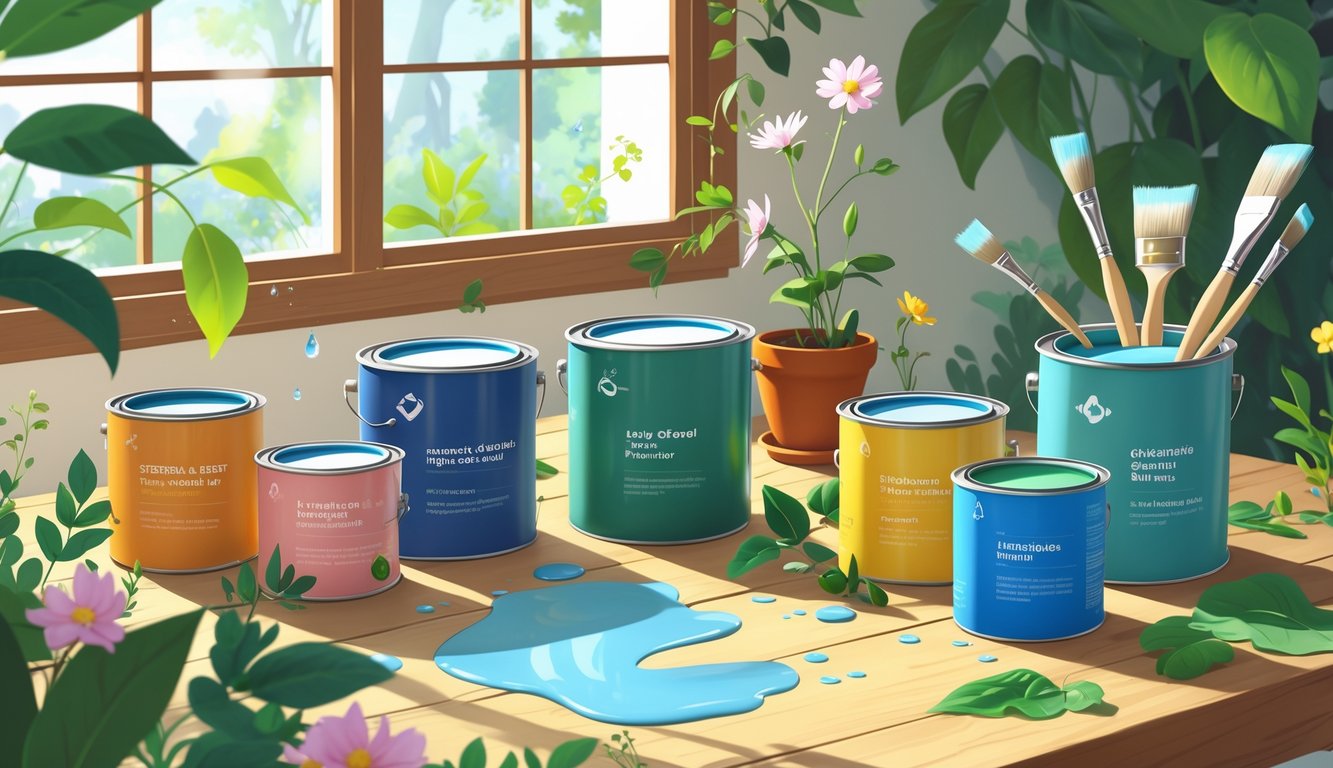
So, paint shopping—what a mess. Seriously, who’s buying these “clean air technology” cans? Some guy handed me one yesterday, swearing it was “healthy.” I just stared at the label, baffled by the ingredient list (half of it reads like a chemistry quiz I never studied for), and those green leaf graphics? Please. Last week, an interior designer flat-out told me that “eco-friendly” paints aren’t always better, which, yeah, checks out. Turns out, even low-VOC or “green” paints can sneak in chemicals, and only certain certifications—stuff like “Certified Eco-Friendly” or “Low-VOC under 50 grams/liter”—mean anything, at least if you believe the experts and sustainability nerds at Livinator and Green Building Solutions. So now I’m squinting at fine print, poking at water-based latex (supposedly 0-50 grams/liter VOCs), and realizing most of the marketing is just a smokescreen.
Don’t even get me started on plant-based binders and “biodegradable” claims. Some PhD chemist told me “biodegradable” means nothing if you can’t trace it past the factory—so, uh, what’s the point? VOC numbers look okay on chalk paint and a few low-VOC brands, but regular stuff? Off the charts. Like, 100 grams per liter? 400? Eco-friendly paint guides basically just confirm my paranoia. And the “renewable raw materials” badge? What does that even mean—soy oil, recycled plastic, unicorn tears? I guess I’m supposed to email the manufacturer to find out. That’ll go well.
I’ve wasted way too much time trying to figure out which green labels aren’t total nonsense and why “natural pigments” matter when my hallway looks like a toddler crime scene. My last “healthy paint” gave me a headache—nobody explains why, and the real info’s buried in legalese or vague marketing. Every paint pro I’ve ever annoyed says the same thing: don’t trust the label, trust the certification. And then, of course, go look up what that certification actually tests for. Because obviously, it’s never simple.
What Does “Eco-Friendly” Paint Really Mean?
I’ve lost count of how many times I’ve seen “eco-friendly” plastered on cans like it’s just another flavor. Does it mean anything? Who’s checking? Off-gassing, toxins, VOC numbers, it’s all a blur. Marketing just keeps stretching the terms, and even the experts don’t agree on the rules.
Defining Eco-Friendly Paint Labels
The first time I looked at “eco-friendly” paint, the label screamed zero-VOC. Okay, but what does that even get me? Sure, under 50 grams per liter is technically a thing (industry guides say so), but not every zero-VOC paint is actually “green.” Chemical binders still sneak in, packaging still feels wasteful, and don’t get me started on “carbon offset” claims—usually just marketing fog.
Microplastics? Single-use plastic? Most brands barely mention them, despite all the “eco” talk. Edward Bulmer (paint royalty, apparently) told Elle Decoration that a real eco product “has no detrimental effect on the environment.” Sure, but where’s the law that actually enforces that? Labels bounce all over the place; consistency is a myth.
Common Terms and Misconceptions
Low odor, green paint, non-toxic—pick your favorite, and someone’s guaranteed to misunderstand the rest. “Eco-friendly paint” isn’t even regulated in most places. Jonsara Ruth (design director, material scientist) says no one agrees on a definition, which feels about right. “Natural pigments”? They might come from sketchy sources too. Sometimes they’re nearly identical to the synthetic stuff you’re avoiding.
And then you get “sustainable,” “responsible,” “earth-friendly”—it’s like a party where everyone’s invited but nobody’s watching the door. Recycled cans, less plastic, but who’s checking the audit trail? You could grab two cans off the same shelf and get totally different definitions of “low-VOC.” No universal logo, no easy way to trust what you’re buying. It’s just a minefield of half-promises and contradictions.
Why Eco-Friendly Matters in Paint
Maybe the only thing anyone kind of agrees on: eco-friendly paints are supposed to cut down on indoor air nastiness and environmental mess. VOCs = bad for asthma, headaches, and all those mystery symptoms. Swapping formulas might help your air, but manufacturers love to say “for your health” even if the new chemical is just less studied, not less toxic. Titanium dioxide, “green” resins—they still cause problems somewhere along the line.
Sustainable packaging and life-cycle impact? Not much evidence in the aisles. I’ve seen recycling programs that skip entire categories, and tins still end up in landfill despite all the “green” branding. Lower carbon emissions, less microplastic, recyclable tins: good steps, but totally inconsistent. Carbon offsets? Unless someone hands me a detailed breakdown, I’m not buying it. “Climate positive” sounds like wishful thinking.
Ingredients That Make Paints “Eco-Friendly”

Let’s talk ingredients—because honestly, half these “non-toxic” and “sustainable” claims hide behind confusing jargon. You think you’re making a safe choice, but reading a paint label is like decoding a prescription in another language. Here’s what actually matters, or so I’ve pieced together—because this is where the “eco” story either holds up or falls apart.
Natural and Plant-Based Ingredients
People can roll their eyes, but have you ever scraped old paint off a window and wondered what you’re breathing in? Plant-based matters. I talked to a UK chemist who basically snorted at the word “natural”—turns out, even “plant-derived” binders can be super refined. Still, some brands really do use clay, chalk lime, or real linseed oil. If you can spot the difference, you’re smarter than me.
I once compared a so-called “natural” acrylic (smelled like a science experiment) with a friend’s homemade safflower oil paint (barely stuck to the wall). Most DIY “natural pigment” mixes—ochre, iron oxide, walnut hull—fade unless you add stabilizers. Certified plant-based paints (look for EcoLogo or GreenGuard) usually skip petrochemicals and formaldehyde. But you gotta read the ingredient list, not just the label hype.
You want chalk finish, milk paint, mineral paint? Go for it. Just don’t expect zero odor or perfect performance. Something’s always a trade-off.
Low-VOC and Zero-VOC Formulations
Here’s what drives me nuts: “low-VOC” is a selling point, but nobody agrees on the number. Under 50 grams per liter? Sure, that’s lower than the old stuff (which could knock you out), but a “zero-VOC” paint (under 5 grams per liter, supposedly) only gets there by playing with the math—add color at the store, and all bets are off. Green Building Solutions says most eco brands stay under 50g/L, but the scary old cans hit 400+.
I’ve chased “low-VOC” latex and zero-VOC acrylics for years, and they still off-gas for days. “Breathe easier” promises? Sometimes true, sometimes just marketing. Indoor air experts say the safe threshold is more of a suggestion—if you’re sensitive, it might not help at all. And “low-VOC” often just means they swapped one chemical for another. Sometimes they add fungicides or softeners that aren’t even regulated. No odors doesn’t mean non-toxic; sometimes they just mask the smell.